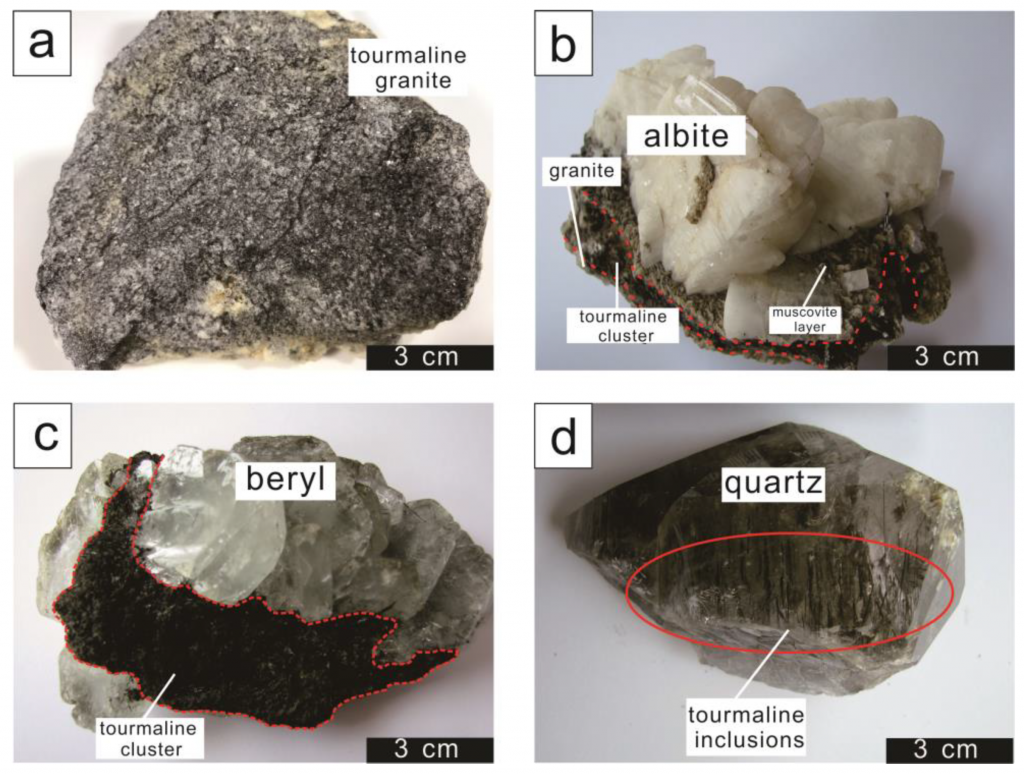Tourmaline as a recorder of ore-forming processes in the Xuebaoding W-Sn-Be deposit, Sichuan Province, China: Evidence from the chemical composition of tourmaline
| Reviews and Highlights | Quantum Science | Molecular and Soft-matter | Ultrafast Nano-optics and Nanophotonics | Mineralogy and Geochemistry |
|---|
Xinxiang Zhu, Markus B. Raschke, and Yan Liu
Minerals 10, 438 (2020).
DOI PDF

The Xuebaoding W-Sn-Be deposit located in the Songpan-Ganze Orogenic Belt (Sichuan Province, China) is a hydrothermal deposit with less developed pegmatite stage. The deposit is famous for the coarse-grained crystals of beryl, scheelite, cassiterite, apatite, fluorite, muscovite, and others. The orebody is spatially associated with the Pankou and Pukouling granites hosted in Triassic marbles and schists. The highly fractionated granites are peraluminous, Li-Rb-Cs-rich, and related to W-Sn-Be mineralization. The mineralization can chiefly be classified based on the wallrock and mineral assemblages as muscovite and beryl in granite (Zone I), then beryl, cassiterite and muscovite at the transition from granite to triassic strata (Zone II), and the main mineralized veins composed of an assemblage of beryl, cassiterite, scheelite, fluorite, and apatite hosted in metasedimentary rock units of marble and schist (Zone III). Due to the stability of tourmaline over a wide range of temperature and pressure conditions, its compositional variability can reflect the evolution of the ore-forming fluids. Tourmaline is an important gangue mineral in the Xuebaoding deposit and occurs in the late-magmatic to early-hydrothermal stage, and can thus be used as a proxy for the fluid evolution. Three types of tourmalines can be distinguished: tourmaline disseminations within the granite (type I), tourmaline clusters at the margin of the granite (type II), and tourmalines occurring in the mineralized veins (type III). Based on their chemical composition, both type I and II tourmalines belong to the alkali group and to the dravite-schorl solid solution. Type III tourmaline which is higher in X-site vacancy corresponds to foitite and schorl. It is proposed that the weakly zoned type I tourmalines result from an immiscible boron-rich aqueous fluid in the latest stage of granite crystallization, that the type II tourmalines showing skeletal texture directly formed from the undercooled melts, and that type III tourmalines occurring in the mineralized veins formed directly from the magmatic hydrothermal fluids. Both type I and type II tourmalines show similar compositional variations reflecting the highly fractionated Pankou and Pukouling granites. The higher Ca, Mg, and Fe contents of type III tourmaline are buffered by the composition of the metasedimentary host rocks. The decreasing Na content (<0.8 atoms per formula unit (apfu)) and increasing Fe3+/Fe2+ ratios of all tourmaline samples suggest that they precipitated from oxidized, low-salinity fluids. The decreasing trend of Al content from type I (5.60–6.36 apfu) and type II (6.01–6.43 apfu) to type III (5.58–5.87 apfu) tourmalines, and associated decrease in Na, may be caused by the crystallization of albite and muscovite. The combined petrographic, mineralogical, and chemical characteristics of the three types of tourmalines thus reflect the late-magmatic to early-hydrothermal evolution of the ore-forming fluids, and could be used as a geochemical fingerprint for prospecting W-Sn-Be mineralization in the Xuebaoding district.
